Affiliate links on Android Authority may earn us a commission. Learn more.
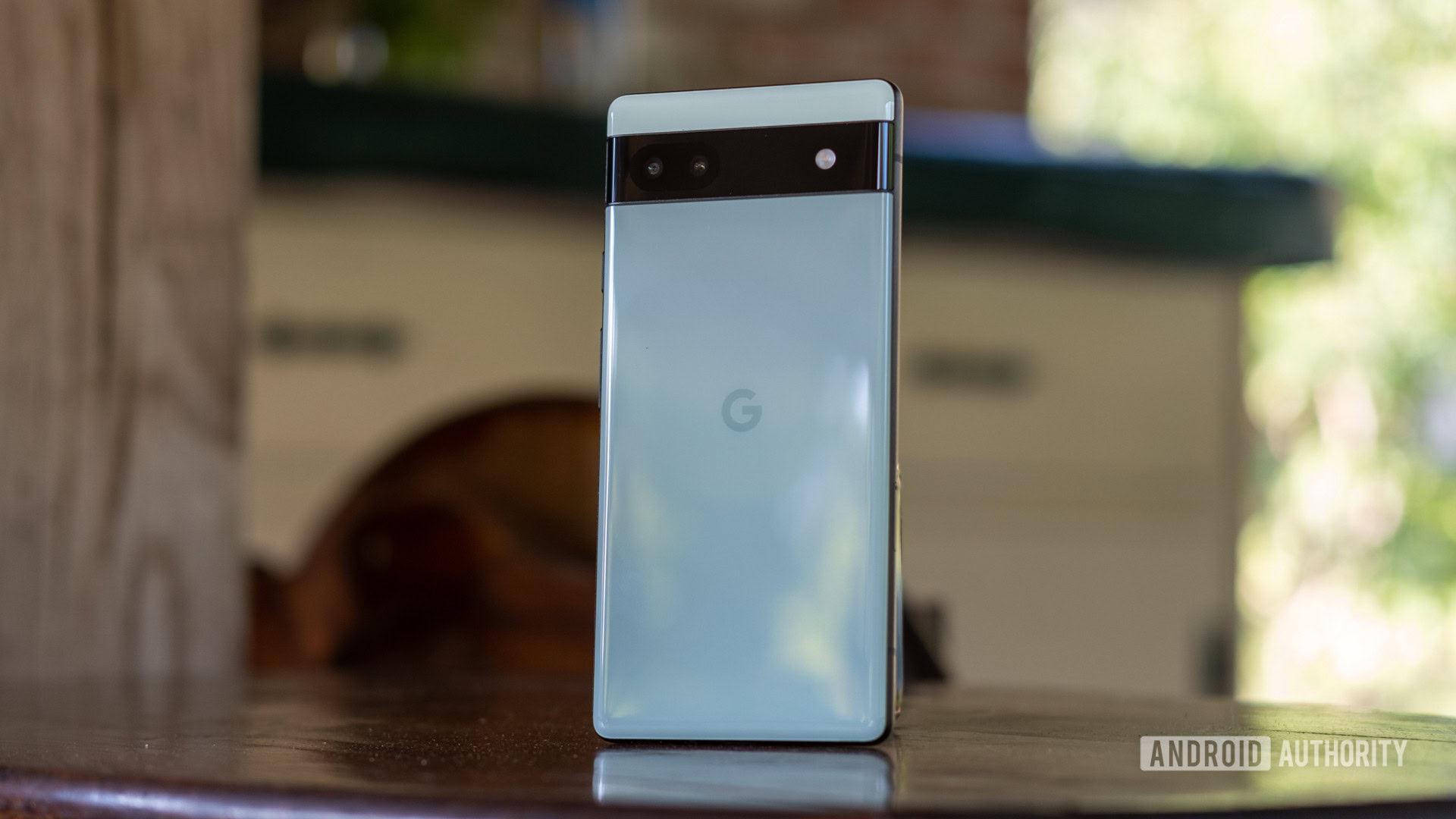

Google Pixel 6a review: Nobody (but Google) puts Google in a corner
May 10, 2023

Google Pixel 6a
What we like
What we don't like
Our scores

Google Pixel 6a
The Google Pixel A series is the opposite of a box of chocolates — you always know what you’ll get. Google will cut some corners with the build materials but make up for it with a low price, clean-as-a-whistle software, and a great camera experience. But with the launch of the Pixel 7a, 2022’s Pixel 6a now has an even lower price. At $349, is the Pixel 6a the best budget phone you can buy? Let’s find out in our Google Pixel 6a review.
Update, May 2023: We’ve updated this Google Pixel 6a review with new competition, details relating to the Pixel 7a, and more.
What you need to know about the Google Pixel 6a
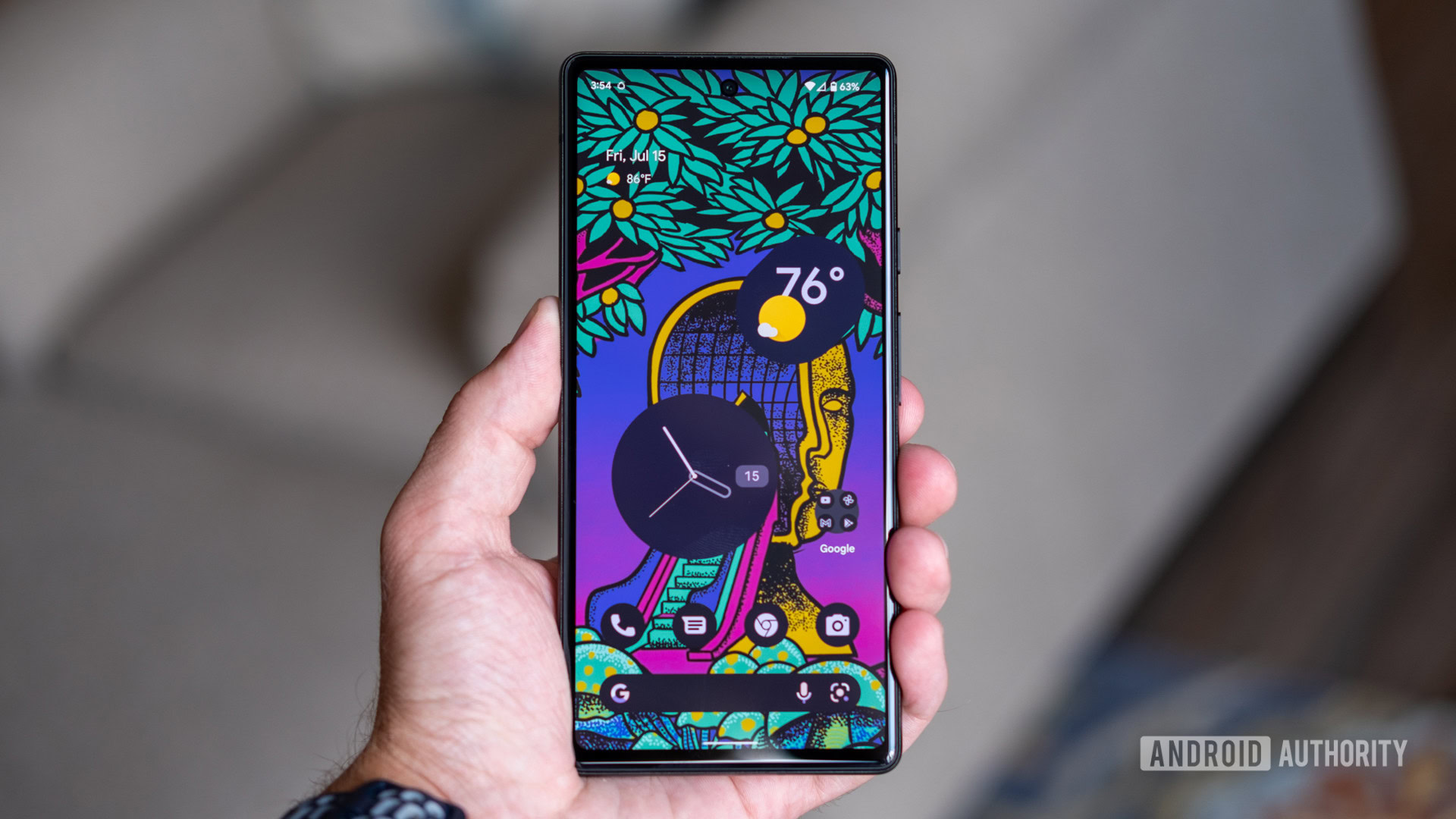
- Google Pixel 6a (6GB/128GB): $449 / £399 / €459
The Google Pixel 6a launched in July 2022 as a direct successor to the Pixel 5a. It’s also the third and most affordable member of the Pixel 6 family. Google’s mid-range device follows the same formula as it always has — blending design elements from its more premium siblings with affordable choices befitting the A series. However, the most significant change is that the Pixel 6a packs Google’s in-house Tensor chip. Google also hasn’t changed the RAM or storage, offering a single version with 6GB and 128GB, respectively.
The Pixel 6a packs a 6.1-inch flat OLED display, the smallest of the Pixel 6 family, and the smallest on the Pixel A series since the Pixel 4a. It’s plenty sharp, with a Full HD+ resolution (1,080 x 2,400), though the refresh rate is limited to 60Hz. The display is Gorilla Glass 3, the frame is a tactile alloy, and the back panel is a 3D thermoformed composite (also known as plastic). No matter the materials, the Pixel 6a is IP67 rated for water and dust resistance.
As the smallest member of the Pixel 6 family, it’s no surprise that the battery capacity takes a hit. The Pixel 6a offers a 4,410mAh cell (smaller than its predecessor) with 18W wired charging through the USB-C 3.1 gen 1 port and no wireless charging. The Pixel 6a’s main camera is a step back from the heights of the Pixel 6 series, though the 12.2MP primary’s capabilities have already been on display in their appearances on the Pixel 4 and Pixel 5 series, while the 12MP ultrawide is borrowed directly from the Pixel 6 and Pixel 6 Pro.
The new Tensor chip is a hallmark of the Pixel 6 series, but the 12.2MP main camera is a callback to Pixels past.
As we’ve seen time and again from many brands over the last few years, the in-box contents are getting lighter. The Pixel 6a offers a 1-meter USB-C cable, a Quick Switch Adapter, a SIM ejector tool, and some simple paperwork in an ever-smaller box.
The Google Pixel 6a launched for pre-orders on July 21, 2022, while the full launch kicked off on July 28. Unlike the Pixel 5a, which you could only buy officially in the US and Japan, the Pixel 6a is available in more than a dozen additional countries throughout Europe and Asia. It comes in three two-toned finishes: Sage (pictured in this review), Chalk, and Charcoal.
How is the new design?
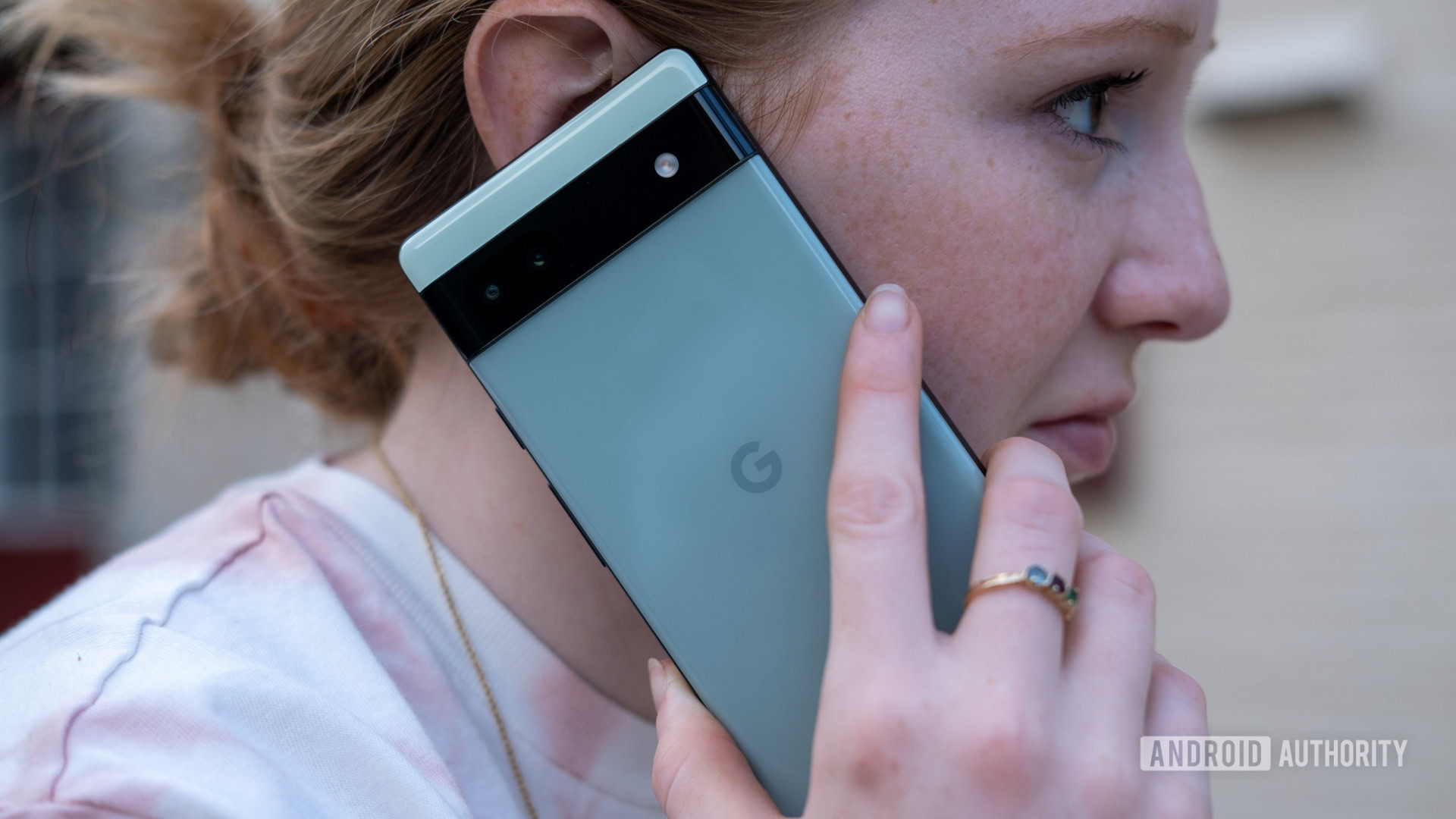
When Google lands on a design, it tends to stick around for a while. The previous Pixel A series installments rarely fell far from their namesake flagships, and the Pixel 6a is no exception. It looks and feels like a Pixel 6 that was left in the sun a bit too long and started to shrivel — in a good way. The boxy Pixel 6 design was a bold step in a different direction and it’s great to see that carry over to its budget line. Google’s two-toned finishes are back as well, though the fun names like Kinda Coral and Sorta Seafoam are gone in favor of straightforward ones like Chalk, Charcoal, and Sage. If you loved the Sorta Sage finish from the Pixel 5, this is as close as we’re bound to get right now. It’s a soft color but still sticks out among a sea of black, white, and gold alternatives.
The repeated design also means that every button and port is right where you might expect it. Both the power button and volume rocker are nestled comfortably on the right side of the Pixel 6a, but they looked off when I first opened the box. It took me a little while to realize why, but the buttons aren’t actually in the center of the alloy frame. Instead, they account for the 3D thermoformed composite back panel and sit in the true center of the device. The slight adjustment doesn’t feel any different, and you won’t notice it when you add a case.
Shrunk like a Pixel 6 that's been left in the sun too long, the Pixel 6a is the perfect size for one-handed use.
While the design is great, the smaller size is even better for small phone fans, especially those who might have been put off by the Pixel 5a’s larger size over previous Pixel A phones. The 6.1-inch display is also much easier to use in one hand than the 6.4-inch Pixel 6 or 6.7-inch Pixel 6 Pro, and I don’t feel like I’m dislocating my thumb to reach across. Colors have also been spot-on in my experience, with wallpapers coming through vibrantly and no loss of detail in streaming content. The flat panel is also sure to appease those wanting nothing to do with the Pixel 6 Pro’s waterfall edges.
However, Google’s decision to limit the display to a 60Hz refresh rate is disappointing. The refresh rate isn’t an entirely surprising cut, but the result is a display that falls far short of the fluidity of the Samsung Galaxy A53 5G’s 120Hz panel. Equally disappointing is the continued use of Gorilla Glass 3 on budget Pixels when other mid-tier phones have higher grades of Corning’s display glass. You’ll definitely still need a good case for the Pixel 6a.
There are visible bezels around all four sides of the display, and the top and bottom are slightly thicker. The earpiece is tucked away in the top bezel, and the only interruption is the central punch hole selfie camera. It has a black border, but it’s easy enough to ignore.
One design trait that seems to have benefitted most from the shrinking process is the camera bar it inherits from the other Pixel 6 phones. It’s no longer thick enough that you could mount it on the wall like a portrait. Instead, the Pixel 6a’s camera bar is only half, or maybe one-third, as thick. I’ve had no issues with gathering dust or fine particles, which has always been a bit of an issue for the two larger members of the Pixel 6 trio.
Google has also finally dropped the axe on the headphone jack — a first for the Pixel A series and a likely casualty of Google’s new design, though its removal is increasingly common in the budget market.
Overall, the Pixel 6a feels great in hand, and the series’ unique design still shines even with the cost-cutting adjustments.
How powerful is the Google Pixel 6a?
The move to Google’s own custom silicon impacts every other aspect of the Pixel 6a, including key features like the cameras and battery life, so let’s talk Tensor. After all, this is the first time a Pixel A series device has skipped a mid-range Snapdragon processor, and you can feel the difference… sometimes literally.
The Pixel 6a sings through daily tasks like email, web browsing, and social media without any issue. I hardly noticed any stuttering, only occasionally when bouncing between labor-intensive apps like music streaming and navigation. Unfortunately, that singing quickly becomes the whistling of a hot tea kettle ready to pour. Google’s Pixel 6a runs hot; really hot. It doesn’t take long to heat up, either. Anything from scrolling Instagram for about 15 minutes to using the camera app is enough to get the Tensor going. We’ve encountered similar issues with the Pixel 6 and Pixel 6 Pro over the months we’d had to test them, but we were hoping to see at least some improvement in the thermal department.
Nevertheless, the Tensor is a powerful upgrade from the previous Pixel A series chips, and the performance numbers back that up. We ran the Pixel 6a through a one-two punch of Geekbench 5 and 3DMark tests, and it landed right alongside its more powerful siblings. The Google Pixel 6a came in right near the premium Pixel 6 Pro on the 3DMark Wild Life test, despite having half of the overall RAM. It also came close to the Pixel 6 on single-core and multi-core Geekbench 5 scores. The differences aren’t drastic, but they show that Google’s in-house chipset hasn’t lost a step in the move to its mid-range home.
When stacked against its mid-range competition, the Pixel 6a shines even brighter. It easily outpaces the Samsung Galaxy A53 5G as well as competing phones available outside the US, such as the POCO F4 and Nothing Phone 1. It’s not the top dog in the budget phone world, though, as somewhat expectedly the Pixel 6a’s numbers come up short of the iPhone SE (2022)’s results thanks to Apple’s flagship A15 Bionic processor.
The Tensor chip brings a new punch to the Pixel A series, so long as you can keep it cool.
The Google Pixel 6a comes in a single configuration with 6GB of RAM and 128GB of fixed storage. While it would be nice to see a few memory options or a microSD slot for those that want more storage space expandable storage, I never felt like the RAM was inadequate during my testing. The lone configuration also includes updated, flagship-tier connectivity support for Wi-Fi 6E and Bluetooth 5.2, and Google’s Titan M2 chip bolsters its security credentials. Modem issues have plagued the Pixel 6 series, but I’ve had no such trouble with the Pixel 6a. It switches networks quickly in my area, and I haven’t had any calls drop for lack of connection.
Is the Google Pixel 6a the best budget camera phone?
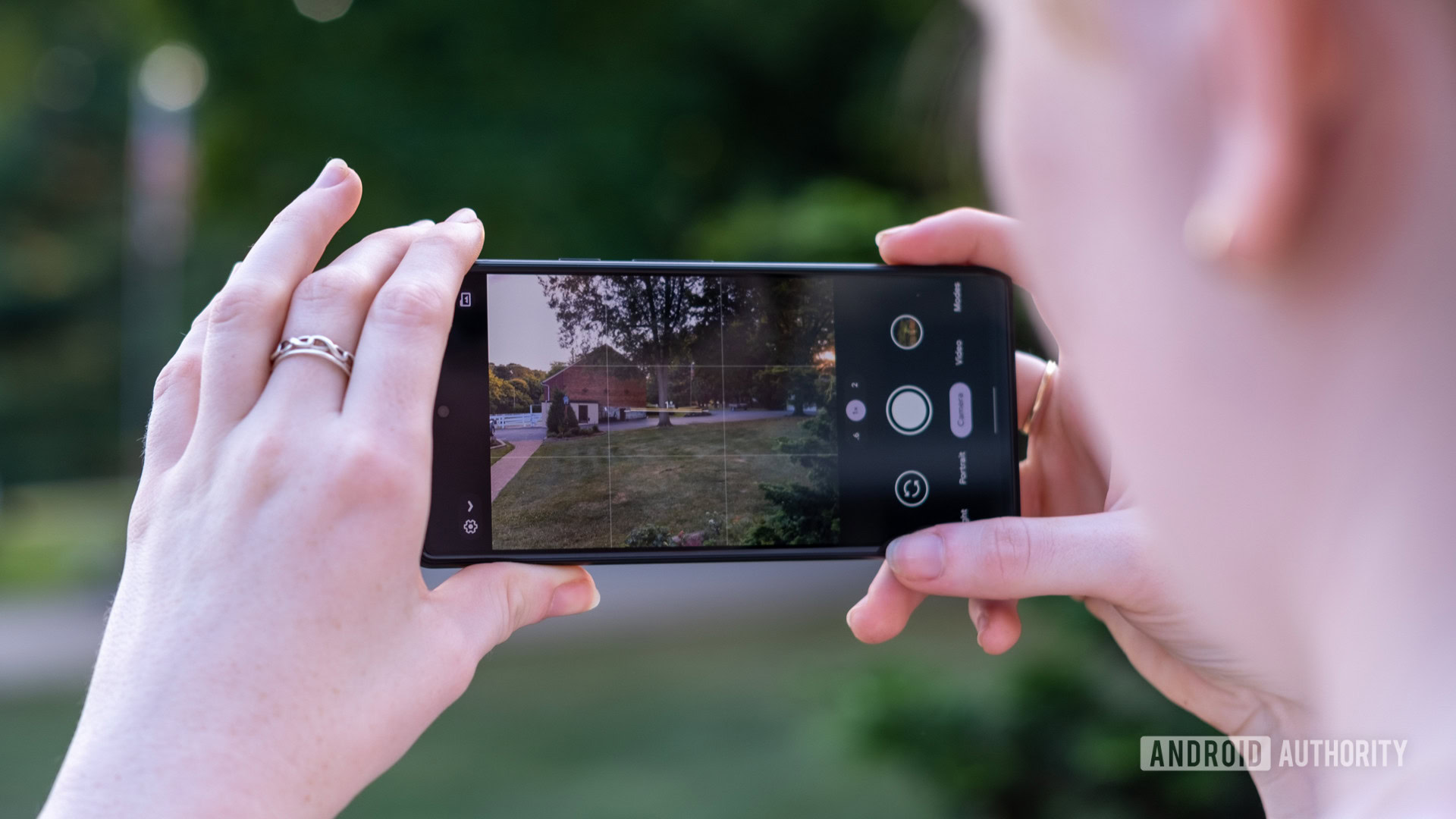
The Pixel 6a walks the Pixel 6 walk in terms of high-style design, but its cameras are more like an old, reliable pair of sneakers. It brings back the familiar 12.2MP primary camera and pairs it with the same 12MP ultrawide shooter found on the Pixel 6 and 6 Pro. The latter has a wide 114-degree field of view, which nicely complements the 77-degree primary camera. There are other smartphone cameras with newer sensors and more megapixels, but Google’s photography continues to push aging hardware far further than it has any right to.
I used the Pixel 6a’s primary camera for the bulk of my shooting, and it delivers results worthy of the Pixel name. The color recreation is accurate, especially in rich sunlight like the image of the flowerpot above. Google’s natural bokeh is impressive, too, and is most evident in the picture of the pink and white flowerbox. I didn’t notice any issues with clouds washing out in the sky, whether I was above them (in the image of the airplane wing) or below (in the image of the waterfall). The only real complaints come if you crop in. No matter how smart Google’s processing is, a camera with a smaller, lower megapixel sensor just doesn’t let in as much light or provide as much information as something like the 50MP shooter on the Pixel 6 and Pixel 6 Pro.
See also: The best camera phones
The ultrawide camera only falls a fraction of a megapixel behind the main shooter, so you don’t sacrifice much quality to fit extra details. It’s particularly helpful for massive subjects like the museum seen above, but you do get a little bit of stretching as you switch between cameras. It’s most visible on the mosaic tile leading up to the museum, as well as in the tree to the far right. I didn’t notice any loss in color quality or consistency between the two cameras, and it can take advantage of Google’s Night Sight mode (more on that later).
Google’s camera app offers three default zoom buttons — standard (1x), ultrawide (0.6x), and zoom (2x). You can pinch in for up to 7x zoom and Google’s Super Res Zoom will upscale crops from the main camera, though I found myself hesitant to reach too far past 4x. The lack of a telephoto lens means that all zoom is digital, and the finer details start to suffer at longer focal lengths. Of course, the Pixel 6 doesn’t have a telephoto either, but its higher resolution primary camera allows for better detail capture. On the bright side, both cameras offer OIS so the zoomed images keep clean borders and don’t pick up any shake from my hands.
Once you get into the more specific shooting modes, it’s easy to see where the Tensor chip shines — or usually shines. Some devices at a similar price point aren’t designed for portrait mode for anything but humans, but the Pixel 6a is ready to put impressive bokeh effects on just about anything. It’s particularly effective on organic shapes, like the fairy and the lion statue seen below, though there are still some issues with edge detection on more industrial shapes like the clock and lamppost.
Some of the more impressive results are actually in the selection of low-light images below. These were all taken with Google’s Night Sight mode, which can be accessed in the camera app’s carousel or through a toggle that appears when the phone detects dim conditions. As an example, the shot of the cat laying on the rug is not as crisp as a daylight shot — it’s not easy to get a cat to sit still for the longer timer — but the detail and sharpness are miles ahead of most mid-range rivals and still packs solid edge detection.
Night Sight results do vary a bit depending on the ambient light. That’s not a surprising statement in itself, considering the phone’s small camera sensor, but I was surprised by the times the Pixel 6a struggled. The image of a tree above looks off as you scan along the wooden fence. The details break down further if you crop in on the leaves and it struggles with exposure from the light source.
However, the image of a bell (below) came out almost spot-on, and you can easily see the effects of Night Sight as you slide from one side to the other. The lighting was far worse for the bell image, yet the results are more pleasing without looking artificial. A few darker areas still bleed into one another, but other colors are night and day in terms of difference. It’s also impressive to see ultrawide Night Sight support, as the Pixel’s closest rivals can’t match it. The iPhone SE (2022) skips night mode altogether, while the Galaxy A53 5G only offers it from the primary camera.
Google’s Magic Eraser feature deserves a mention as well. It launched with the Pixel 6 series, and it’s particularly helpful in a tourist-heavy area like Vancouver. I tried to capture the shot of the lighthouse above before anyone walked into frame, but the woman beat me to it. Magic Eraser automatically identified her for removal, and all I had to do was press Accept. The erasure isn’t perfect, but it’s not noticeable unless you’re looking at the railing. Other brands offer similar object removal tools, but Google’s is by far the most consistently impressive.
The Google Pixel 6a only offers an 8MP selfie shooter, but don’t tell that to the results. I have (occasionally) wild hair, yet it’s captured in full detail both with and without portrait mode. The portrait mode result does skip a few hairs, but it’s tough to complain about a few blurred-out wisps. More importantly, the color recreation is great, and there’s no beauty filter or any retouching that I’d be drawn to turn off. The clouds in the far background lose a little detail in the standard selfie, but everything else looks good for a budget selfie snapper.
Google hasn’t reimagined its video capabilities from the Pixel 5a, but it’s not a glaring issue. The rear cameras still deliver 4K at up to 60fps, with 1080p at up to 240fps as an alternative option. You can tap into slow motion and timelapse modes for some added flexibility. However, the front-facing camera tops out at 1080p at 30fps, which is behind offerings from both Apple and Samsung. The Galaxy A53 5G, for example, packs 4K at 30fps on its front lens, and the iPhone SE (2022) reaches 1080p at 120fps from its own selfie shooter.
The Pixel 6a has a high-style design, but its cameras are more like an old, reliable pair of sneakers.
Google’s camera app is still fairly bare bones, with tabs for portrait mode and Night Sight but no in-depth manual controls. It loses the Pixel 6’s Motion photos feature, so Action Pan and Long Exposure are off the table. On the bright side, you can still try Face Unblur, Real Tone, and the aforementioned Magic Eraser to get the best out of your shots.
Overall, the Pixel 6a’s camera setup is still a leader in the mid-range segment. It shines with the enhanced image processing power of the Tensor chip, though the camera hardware itself is beginning to show its age. The pair of lenses is no longer among the most advanced, but consistent point-and-shoot results and features like Magic Eraser and Real Tone make it easy enough to ignore the man behind the curtain.
If you want to take a closer look at the samples, check out the full-resolution images in Google Drive here.
How is the battery life?
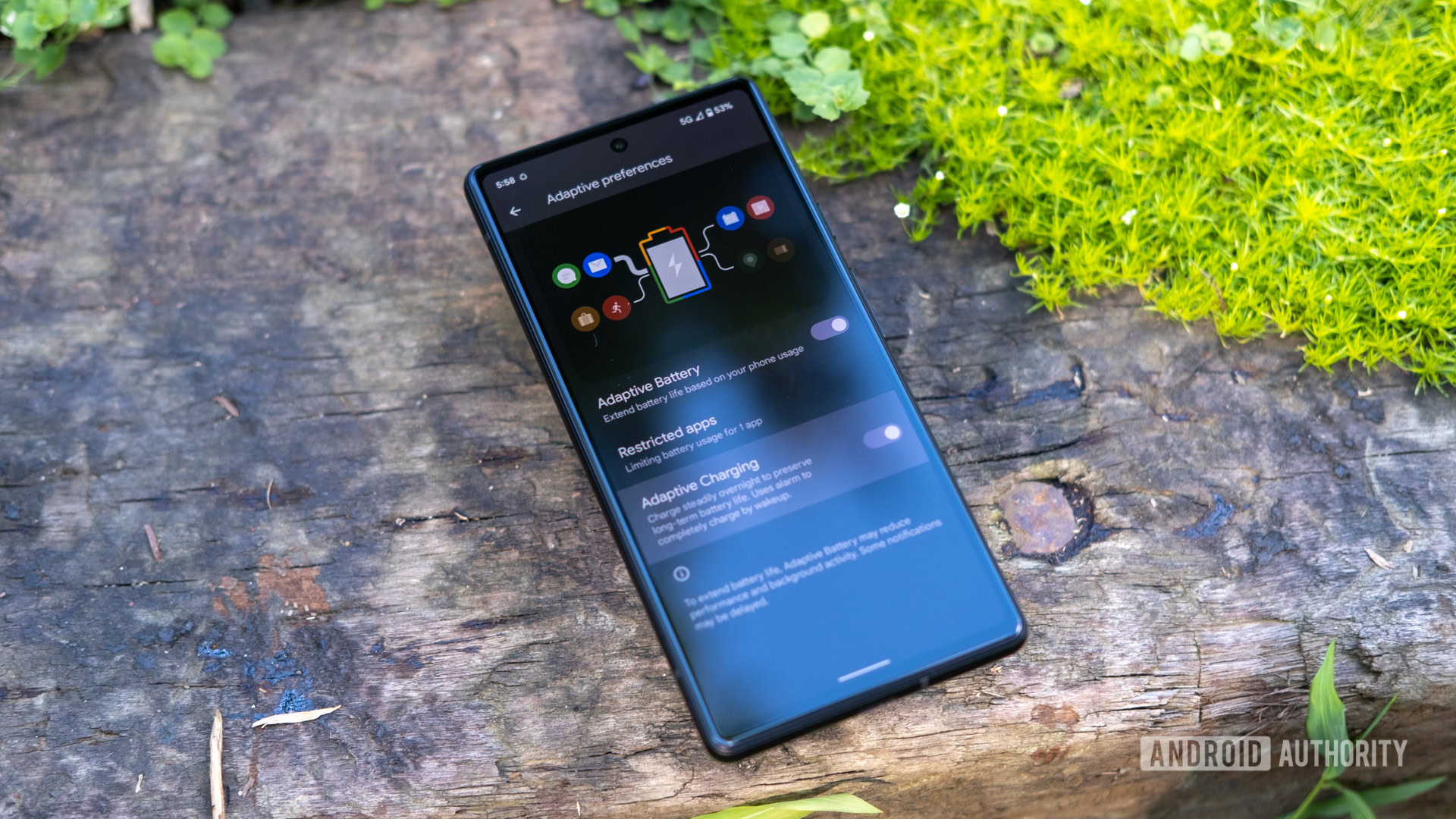
The main casualty of the Pixel 6a’s smaller design, and the adoption of the Tensor chip, is the battery. It took about a 200mAh hit from the capacity of the Pixel 6 (4,410mAh) and just shy of 300mAh from the Pixel 5a (4,680mAh). Though it’s still not a small cell by any means, it’s compounded by improved hardware that chugs through power rather than sipping it.
Google boasts that the Pixel 6a is ready for over 24 hours on a single charge at regular usage, but I’ve had trouble matching that tally. In the two weeks I’ve been testing, I’ve rarely achieved more than a day’s worth of power. It’s a little better during the work week when I’m not checking my phone often, but it’s still behind most mid-rangers which can push to a day and a half or more on light use. Typically, I woke up with a full battery, but I was usually glancing nervously at my remaining charge by about 9:00 PM even with Adaptive Battery turned on. I might go to bed with about 10% left, but then I’m guaranteed to need a charger first thing in the morning.
Power Saver is a must-use to overcome the Tensor's appetite for power.
On the weekends, when I have time to be a bit more adventurous, the results suffer even more. Anything that warms the Tensor chip — which is almost everything — chews through the battery in a hurry. I often spend long stretches of my weekend streaming Spotify in my car and using periodic GPS navigation, and I’ve run into instances where the battery is sitting around 60-65% by 1:00 PM. Gaming is a similar story, as demanding titles like Genshin Impact and Asphalt 9 put serious pressure on the battery’s longevity. Our in-house battery stress test backed up our observational findings too. After a 90-minute loop at maximum brightness, the Pixel 6a drained 21% of the total battery while the Pixel 6 drained by just 6%.
The Pixel 6a’s Power Saver is often a saving grace, and I turned to it regularly throughout my testing. It limits the overall performance but keeps the Tensor chip cooler and stretches the battery further. I had to rely on it for a long travel day, turning it on at about 80% battery remaining, and I still finished the day with about 30%.
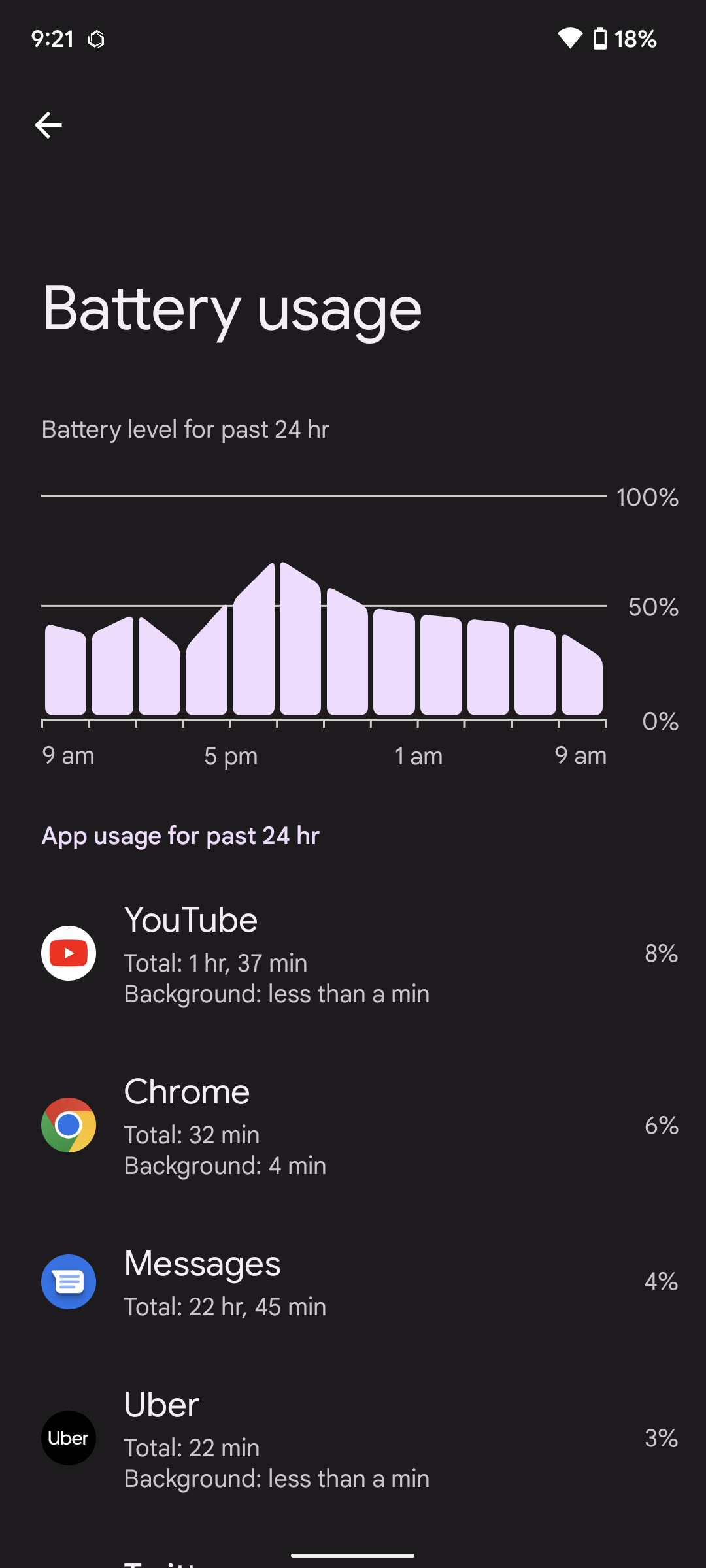
Google is a bit more secretive about screen-on numbers these days, offering a 24-hour graph instead. In the screenshot above, you can see the steepest drops from around 1:00 PM to 3:00 PM and then again from around 7:00 PM to when I went to bed. Battery drain isn’t severe overnight, but it does result in a noticeable drop by morning, and picks up speed when I’m active before work.
When you do manage to burn through the Pixel 6a’s battery, you’ll have to turn to 18W wired charging to get back on your feet. Like the Pixel 5a, it relies on standard USB Power Delivery, so most recent chargers should be capable of hitting top speeds. There isn’t one in the box, so if you don’t have one be sure to check out our wall charger guide to find the best option.
The wired charging is a little slower than what Google offers with the Pixel 6 series, and there’s no wireless option to take advantage of. In practice, it’s in line with previous Pixel A series devices, though the smaller battery cuts a few minutes off the charging time. It picked up about 65% charge in one hour with a compatible brick, taking about an hour and 45 minutes to fill. Despite the smaller battery, these numbers are behind some of the Pixel 6a’s closest rivals. The Galaxy A53 5G fills its 5,000mAh cell in 85 minutes, and the iPhone SE (2022) reloads in about an hour (and supports wireless charging).
Related: The best phone charging accessories
Anything else?
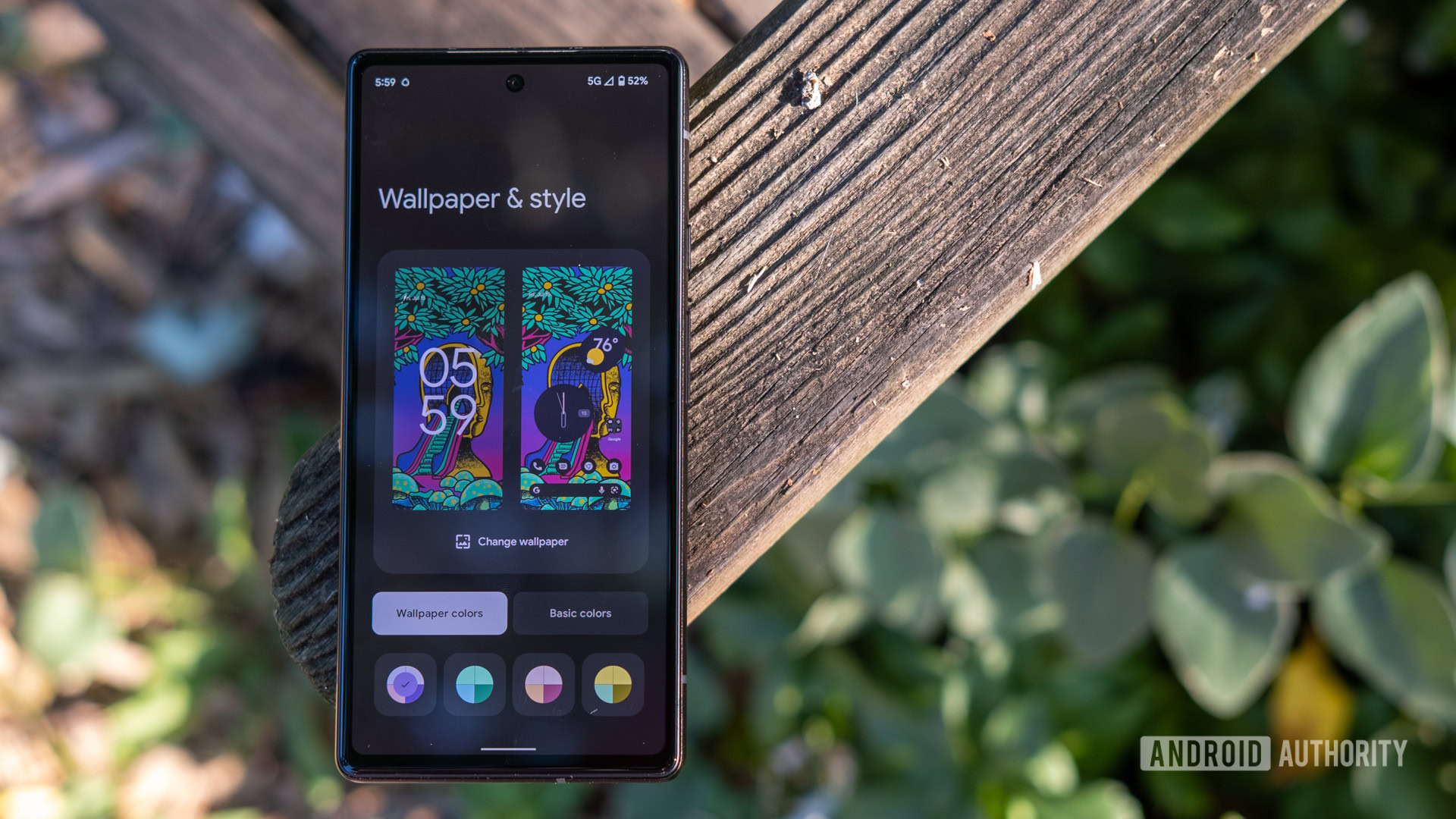
- Biometrics: The Pixel 6a carries an in-display optical fingerprint sensor like its Pixel 6 siblings, but fear not — it’s not the same sensor. Instead, the Pixel 6a packs an updated version that, in my experience, is far more reliable and faster. It sits about four centimeters from the bottom edge, which is a bit high, but it’s easy enough to reach given the smaller display.
- Audio: Google’s mid-range phone offers stereo speakers, combining the earpiece with a down-firing unit. While anything below 25% volume is very soft, the speakers are loud by 50% and can fill a room when full. I noticed a tiny bit of distortion at full volume, and there are obvious limits to the bass, but you’re better off with a Bluetooth speaker at that point. As previously noted, there’s also no headphone jack on the Pixel 6a — a change from the Pixel 5a — but there’s a decent array of Bluetooth codec support for wireless audio.
- Haptics: Quality haptics are no guarantee in the mid-to-budget-tier, but the Pixel 6a continues Google’s trend of excellence. The vibration motor is tuned expertly and responses to taps are nice and clicky.
- 5G: The Tensor chipset supports 5G networking, and my experience on Verizon’s network was smooth. The unlocked model only comes with sub-6GHz compatibility, though you can pick up a mmWave-compatible version from Verizon. However, this comes at a $50 premium and is unlikely to make a difference outside of major cities in the US. Likewise, the lack of mmWave is a non-factor in most other countries.
- Software: The Google Pixel 6a ran on Android 12 for the duration of my testing but has since received Android 13. Pixel UI is light and fast, as usual, and it’s packed to the brim with Pixel-exclusive features and apps, and Material You theming options. It’s easy to match first-party app icons and widgets to your background, and there aren’t many limits to your customization. It even supports the magical offline Google Assistant voice typing feature that debuted on the Pixel 6, which is enabled by the on-device machine learning smarts of the Tensor chip. Google also doesn’t weigh you down with third-party bloatware and you can delete many of Google’s own apps if you don’t want them, with a few exceptions. Just don’t expect any features not already seen on the Pixel 6 — this is very much the modern Pixel software experience we’ve come to expect.
- Updates: Software updates have become a race between Samsung and Google. The Pixel 6a boasts five years of “Pixel Updates,” which means five years of security patches but three years of overall Android version updates. It may not match Samsung’s total commitment which extends to four years of upgrades, but the Pixel 6a is still one of the best supported budget phones you can buy. It will stay up to date until Android 15 in 2024 and continue to receive security coverage until 2027. Don’t forget that Google is always one of the first to roll out new software, and there are bound to be some Feature Drops in the future.
- Connectivity: Google’s Pixel 6a supports Dual-SIM in the form of a single nano-SIM and optional eSIM. It also delivers the latest connectivity options, with Bluetooth 5.2 and Wi-Fi 6E onboard — that’s some impressive future-proofing for a phone at this price tier and a big improvement over the Pixel 5a. NFC support is present, too, so Google Pay will work without issue. The only thing it lacks over the Pixel 6 proper is ultra-wideband (UWB) support, but use cases are low and it’s a mostly flagship-only feature.
Google Pixel 6a specs
| Google Pixel 6a | |
|---|---|
Display | 6.1-inch OLED 20:9 aspect ratio FHD+ resolution 1,080 x 2,400 429ppi 60Hz refresh rate HDR support 24-bit depth Gorilla Glass 3 |
Processor | Google Tensor |
RAM | 6GB LPDDR5 |
Internal storage | 128GB UFS 3.1 |
Battery and power | 4,410mAh 18W fast charging USB-C 3.1 Gen 1 |
Cameras | Rear: - 12.2 MP dual pixel wide camera, 1.4μm, ƒ/1.7, 77-degree FoV, 1/2.55-inch, OIS/EIS - 12MP ultrawide, 1.25μm, ƒ/2.2 aperture, 114-degree FoV Front: - 8MP single, 1.12μm, ƒ/2.0, fixed focus, 84-degree FoV Magic Eraser Real Tone Face Unblur Night Sight Super Res Zoom up to 7x |
Video | Rear: 4K at 30/60FPS 1080p at 30/60FPS Front: 1080p at 30FPS |
Audio | Stereo speakers Dual mics Bluetooth 5.2 No 3.5mm port |
Security | In-display fingerprint Titan M2 chip 5 years' security updates |
Sensors | Proximity sensor Ambient light sensor Accelerometer Gyrometer Magnetometer Barometer |
Water resistance | IP67 |
Connectivity | Wi-Fi 6 (802.11ax) Wi-Fi 6E (6GHz) Bluetooth 5.2 NFC support Dual SIM (single nano-SIM and eSIM) Google Cast GPS, GLONASS, Galileo, QZSS, BeiDou |
Bands | [5G Sub 6 GHz]14 Model G1AZG GSM/EDGE: Quad-band (850, 900, 1800, 1900 MHz) UMTS/HSPA+/HSDPA: Bands 1,2,4,5,6,8,19 LTE: Bands B1/2/3/4/5/7/8/12/13/14/17/18/19/20/25/26/28/29/30/32/38/39/40/41/42/48/66/71 5G Sub-614: Bands n1/2/3/5/7/8/12/20/25/28/30/40/48/66/71/77/78 |
Software | Android 12 Pixel UI |
Dimensions and weight | 152.2 x 71.8 x 8.9mm 178g |
Colors | Sage, Chalk, Charcoal |
In-box contents | 1m USB-C to USB-C cable (USB 2.0) Quick start guide Quick Switch adaptor SIM tool |
Value and competition


Google’s Pixel 6a started at $449 in the US, right where the Pixel 5a sat the year prior. It offered a lot for the money, with an upgraded processor, an exceptional commitment to updates, and Google’s vaunted image processing. Now, it retails for just $349, making it an absolute bargain for anyone that wants the Pixel experience on a budget.
The most direct competitor now comes from its own family. The Google Pixel 7a ($477 at Amazon) brings a host of improvements to the Pixel 6a, including wireless charging support and a 90Hz display. However, the overall allure of the newer product is rather dulled by its $50 premium (and $150 difference from the 6a), while it still struggles to remain cool thanks to the Tensor G2 SoC’s heated tendencies.
Right there to poke at Google’s flaws is the Samsung Galaxy A54 5G ($379.5 at Amazon). It’s the closest mid-range Android rival, and it even keeps its predecessor’s price while many phones are increasing in that regard. The Galaxy A54 5G is also larger, complete with a 6.4-inch AMOLED display with a smooth 120Hz refresh rate. Buyers get a larger 5,000mAh battery that lasts much longer, and the 25W wired charging beats the Pixel, too, although there’s no wireless charging support here. You also get that extra year of Android version upgrades. The Pixel 6a does claim some wins, though. Samsung may have more rear shooters than the Pixel 6a, but we struggled to reign in the Galaxy A54 5G’s oversaturation. Both phones carry an in-house chipset, though Samsung’s Exynos SoC isn’t as powerful as Google’s Tensor (though it does run cooler).
Motorola has been busy capitalizing on the space that LG left behind, and its Moto G Stylus 5G ($102.69 at Amazon) is its best budget offering right now. It’s large, with a 6.8-inch display, but that bigger body hides a stylus and a large 5,000mAh battery. The Moto G Stylus 5G matches the Pixel 6a with a 6GB and 128GB base configuration, though you can pick it up with 8GB and 256GB if you’re determined to put the phone to the test. There are a few other differences consistent with Motorola’s budget family — a Snapdragon 695G chipset, a water-repellent (not IP67 rated) plastic build, and a familiar side-mounted capacitive fingerprint reader. It’s a good pick if you need a stylus but don’t want to splash for the mega-money Galaxy S23 Ultra, but a weak update commitment, underpowered cameras, and even slower wired charging hold the Moto G Stylus 5G back for everyone else.
Though the Galaxy A54 5G and Moto G Stylus 5G are worthy Android rivals within the mid-range price bracket, there’s another elephant in the room: Google’s own Pixel 7 ($545 at Amazon), which picks up right where the Pixel 6 left off. Although you have to spend a little more, the improvements are more than worth the extra investment. For starters, the Pixel 7 is a tough customer. It’s made with Gorilla Glass Victus on both the front and back and an alloy frame. It keeps the 50MP primary camera and 12MP ultrawide, but the duo has the benefit of Google’s newer Tensor G2 chipset. Google’s affordable flagship packs a bigger battery with quicker wired charging, and it puts wireless charging back on the table. The Pixel 7 even improves the refresh rate to 90Hz, tips from an IP67 rating up to IP68, and throws in more RAM. While the price gap is much wider after the Pixel 6a’s price cut, the Pixel 7 is still undeniably great value.
The Pixel 6a stacks well against its mid-range rivals, especially after its price cut.
Over on the Apple side, the iPhone SE (2022) ($429 at Amazon) completes our budget battle royale. It might not have a modern design (or any design upgrades at all over iPhones circa 2017), but the real upgrades are hiding inside. Like the Pixel 6a, the iPhone SE packs a flagship processor for a wallet-friendly price. It carries the same A15 Bionic chipset that you’d find on the iPhone 13 series, and it puts up benchmark numbers like a phone double its cost. Even though the iPhone SE is one of the smallest phones you can buy, it stretches its ~2,000mAh battery to marathon lengths. However, you’re stuck with a tiny, low-res 4.7-inch LCD, a lone rear camera with an underbaked feature set, and a meager 64GB of storage for the base model.
In good news for global buyers, the Pixel 6a is also far more widely available than the Pixel 5a. That opens the door to other compelling competitors that are worth checking out, such as the POCO F4 ($429 at Amazon), Nothing Phone 1 (£399.99 at Amazon), and OnePlus Nord 2T ($389 at Amazon).
Read next: 10 ways to make your Google Pixel 6a better
Google Pixel 6a review: The verdict
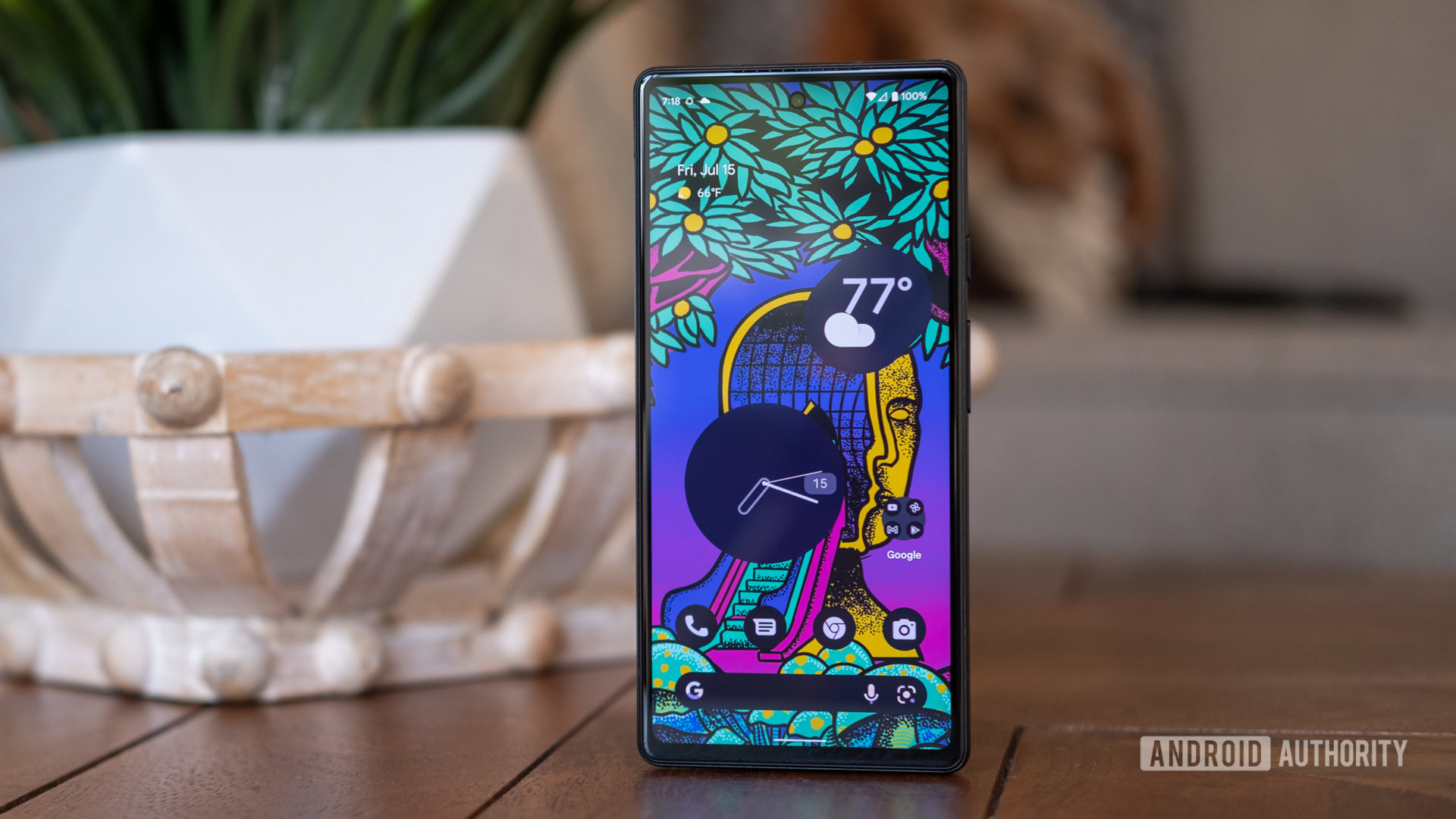
There’s a lot to like about the Google Pixel 6a. It falls right in the sweet spot for one-handed use with its 6.1-inch OLED display, but it keeps the Pixel 6 design traits and overall build quality we’ve come to love. The Pixel 6a even incorporates Google’s in-house Tensor chip for the first time. And while it does struggle with sustained performance due to some overheating issues, it’s still a nice kick over the mid-range Snapdragon offerings of past budget Pixels.
At launch, we said the Pixel 6a would be an incredible deal if it sold for $349; a sub-$400 price would’ve papered over some of the more notable cracks, especially the not-so-great battery life and 18W wired charging, both of which come up short of some of the Pixel 6a’s closest rivals. And while the display is great, the 60Hz-locked refresh rate makes it less satisfying to use than some alternatives.
The Google Pixel 6a pulls some of the best Pixel 6 (and Pixel 7) features into a smaller and more affordable package.
Now, with the price drop to $349, this Pixel is as sweet as any other, and it makes spending an extra $150 on the Pixel 7a tougher to justify.
If you’ve been clamoring for a smaller Pixel with the full-scale Tensor experience, this is your man… er, phone. It’s capped in terms of RAM and storage, as all Pixel A series devices are, but you’re not likely to notice either factor in day-to-day life. What you’re more likely to notice is the smooth Pixel UI experience, the enjoyable Material You customizations, and the clever imaging algorithms that keep Google besting the budget competition despite the device’s aging camera hardware.
Top Google Pixel 6a questions and answers
The Pixel 6a is available in 13 countries: United States, United Kingdom, Canada, Germany, Ireland, France, Italy, Spain, Japan, Australia, Singapore, Taiwan, and India.
Yes, the Google Pixel 6a is smaller than the Pixel 6. It offers a 6.1-inch display instead of a 6.4-inch display. The Pixel 6a is also smaller than the previous Pixel 5a.
No, the Google Pixel 6a is the first Pixel A series device to skip the headphone jack.
The Pixel 6a has an IP67 rating for protection against the effects of immersion in water at up to one meter for up to 30 minutes.
The Google Pixel 6 offers more overall. It has a bigger screen with a higher refresh rate, more RAM, a better main camera, a bigger battery, and faster charging. It also supports wireless charging. For a more detailed comparison between the two, check out Google Pixel 6 vs Pixel 6a post.
Yes, the Google Pixel 6a supports 5G networks. However, the unlocked models only come with sub-6GHz compatibility, while Verizon models also support mmWave.
Thank you for being part of our community. Read our Comment Policy before posting.